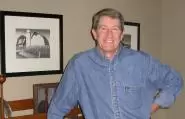A Tale of Two Clocks

Last week I found myself zipping along I-74 just north of Davenport, Iowa, when I decided to drop in on an old friend. My ‘friend’ happens to be a grandfather clock, one of only five believed to have been made by the Roycrofters under the direction of Elbert Hubbard. This particular one has been on display at the Palmer Chiropractic College in Davenport ever since it was made for B.J. Palmer (1882-1961) around 1915.
Grandfather clocks by any of the major Arts & Crafts furniture makers are a rarity, but the Roycrofter’s are the rarest of all. Whereas Gustav Stickley and L. & J.G. Stickley clocks were produced for several years and continue to appear on the market today, Roycroft clocks were never advertised, never placed into production and, to the best of my knowledge, have never appeared at an Arts & Crafts auction or show.
The two most famous of the Roycroft clocks were made for the Grove Park Inn, which opened in 1913. The shorter of the two, a mere six-footer, spent most of its life in one of the hotel offices and suites until it was placed on public display several years ago. The larger, standing an impressive eight feet tall, has always been in or near the Great Hall, where it has greeted guests ever since 1913.
Always a bit of an eccentric, Elbert Hubbard was clearly out-done in that category by his friend B.J. Palmer, who became president of the Palmer School of Chiropractic upon the death of his father (and rival) in 1913. The rumor that B.J. had purposely run over his abusive father with his automobile during a homecoming parade hounded him for the remainder of his life.
Palmer had a personal and professional fascination with human skeletons, which he collected like we collect furniture or art pottery. Dozens of them are still on display in the hallways of Palmer Chiropractic College, along with a large photograph of B.J. Palmer surrounded by more than 25 hanging skeletons. My favorite, though, is a picture of Palmer adjusting the vertebra of a skeleton posed facedown on a chiropractor’s couch.
But Palmer also loved Roycroft furniture and ordered numerous pieces from the Roycrofters, several of which are still in use around the school. And inside the Special Collections room of the library is the pride of their collection — an eight-foot grandfather clock (pictured).
Palmer’s clock bears such a striking resemblance to one at the Grove Park Inn that it is easy to believe they were designed by the same craftsman and produced around the same time. While not identical, they both feature the same case construction, door pulls, butterfly hinges and a large hammered copper face. If Victor Toothaker, a metalsmith, furniture designer and woodworker at Roycroft around 1913, designed the Grove Park Inn clock, then he may well have designed the Palmer clock as well.
We do know that B.J. Palmer stayed at the Grove Park Inn, but I have been unable to determine whether he ordered a clock for himself after seeing the one in the Great Hall or whether his model already existed.
Like the clocks at the Grove Park Inn, B.J. Palmer’s clock resides in safe hands and is well-cared for. Odds are, though, that neither of these clocks will likely appear in any Arts & Crafts exhibition, so if you ever find yourself anywhere near Davenport and have an interest in rare Roycroft furniture (or human skulls and skeletons), drop in — and make a friend.

Until next Monday,
Bruce Johnson
